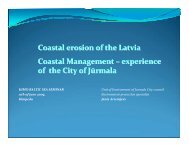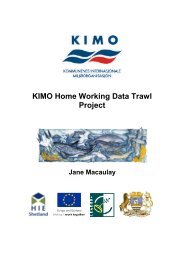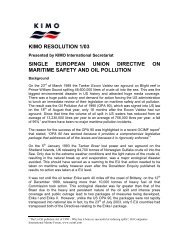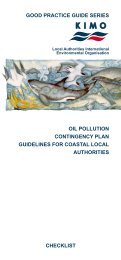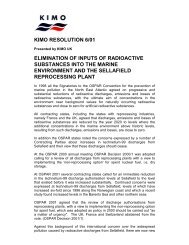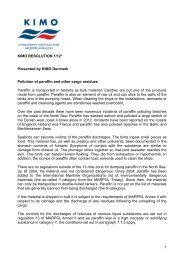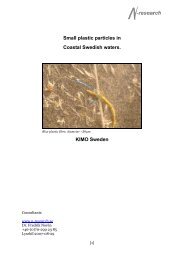The aftermath of the beaching REPORT OF AN INQUIRY
The aftermath of the beaching REPORT OF AN INQUIRY
The aftermath of the beaching REPORT OF AN INQUIRY
Create successful ePaper yourself
Turn your PDF publications into a flip-book with our unique Google optimized e-Paper software.
SCHEDULE <strong>OF</strong> RECOMMENDATIONS WHICH ARISE FROM OUR FINDINGS<br />
5<br />
C. LOCAL CONTINGENCY PL<strong>AN</strong>NING<br />
5.5 Coastal Emergency/Contingency Planning appears to vary from local authority to local<br />
authority and agency to agency. Not all coastal authorities have plans specifically<br />
addressing <strong>the</strong>ir shorelines and <strong>the</strong> immediate hinterland. Pragmatically that hinterland<br />
extends to <strong>the</strong> first ‘main’ road (A or possible B) connecting <strong>the</strong> area <strong>of</strong> any future<br />
incident to o<strong>the</strong>r physical communication lines or centres with appropriate facilities, but<br />
where such roads are on <strong>the</strong> coast itself <strong>the</strong>re will be some o<strong>the</strong>r sensible inland<br />
boundary. We are in no doubt that a general county or unitary area-wide Emergency<br />
Plan must be in place, and that a Shoreline Contingency Plan may be attached to it. BUT<br />
that Shoreline Plan should not be buried within <strong>the</strong> general emergency plan, or worse,<br />
its separate components scattered through it under apparently appropriate headings.<br />
We are aware that planning for managing incidents <strong>of</strong> oil pollution and its attendant<br />
treatment is by now in place on <strong>the</strong> whole coastline (indeed <strong>the</strong> NCP concentrates on it<br />
having hinted that o<strong>the</strong>r ‘pollution’ is involved). Its implementation is well rehearsed,<br />
but as <strong>the</strong> Napoli incident demonstrated that implementation is not foolpro<strong>of</strong>, needs<br />
tightening, and thus planning needs adjustment. (<strong>The</strong> Axmouth estuarine pollution on<br />
13th July 2007 refers). It may be that be that coastal cells would be a better basis for<br />
planning for contingency than LA boundaries ra<strong>the</strong>r as <strong>the</strong> EA has adopted catchment<br />
plans which inevitably straddle administrative boundaries<br />
5.6 RECOMMENDATIONS (3.14 d also refers)<br />
1. That all principal coastal authorities should be required to construct or immediately<br />
review a Shoreline Contingency Plan (SCP), and ensure that it covers <strong>the</strong> immediate<br />
hinterland as defined in 5.5, it should be separate from, even if supplemental to,<br />
<strong>the</strong>ir existing authority wide Emergency plan.<br />
2. That <strong>the</strong> SCP should cover all forms <strong>of</strong> physical pollution (as <strong>the</strong> present NCP hints)<br />
not just those involving oil and o<strong>the</strong>r liquids, but potential environmental change<br />
and damage by inert solids and gaseous movement onshore.<br />
3. That consideration should be given to relating SCPs to natural coastal ‘cells’ –<br />
lengths <strong>of</strong> coast with a marine factorial unity such as Great West Bay, Lizard to<br />
Dodman, Dodman to Prawle etc. ra<strong>the</strong>r than using local authority boundaries. (If<br />
adopted <strong>the</strong>n all LAs involved should share construction and review <strong>of</strong> a single<br />
SCP).<br />
4. That all SCPs should be reviewed annually (not quinquennially as in <strong>the</strong> NCP) and<br />
updated in <strong>the</strong> light <strong>of</strong> any incidents reported in <strong>the</strong> intervening 12 months.<br />
5. That <strong>the</strong> LGA Coastal Issues Group should be upgraded to committee level with<br />
dedicated <strong>of</strong>ficer support, and given <strong>the</strong> responsibility (even if voluntarily) <strong>of</strong><br />
overseeing <strong>the</strong> monitoring <strong>of</strong> <strong>the</strong> efficacy <strong>of</strong> <strong>the</strong> review <strong>of</strong> such plans and act as a<br />
formal clearing house for communicating incident occurrence and lessons learned<br />
from <strong>the</strong>m to all coastal authorities.<br />
6. That Highway Authorities with coastlines should prepare a generic plan for <strong>the</strong><br />
emergency management <strong>of</strong> extraordinary traffic on <strong>the</strong> road, byway and path<br />
network <strong>of</strong> <strong>the</strong>ir coastal zones (as defined in 5.5 above).<br />
MSC Napoli <strong>The</strong> <strong>aftermath</strong> <strong>of</strong> <strong>the</strong> <strong>beaching</strong> Report <strong>of</strong> an inquiry 29



